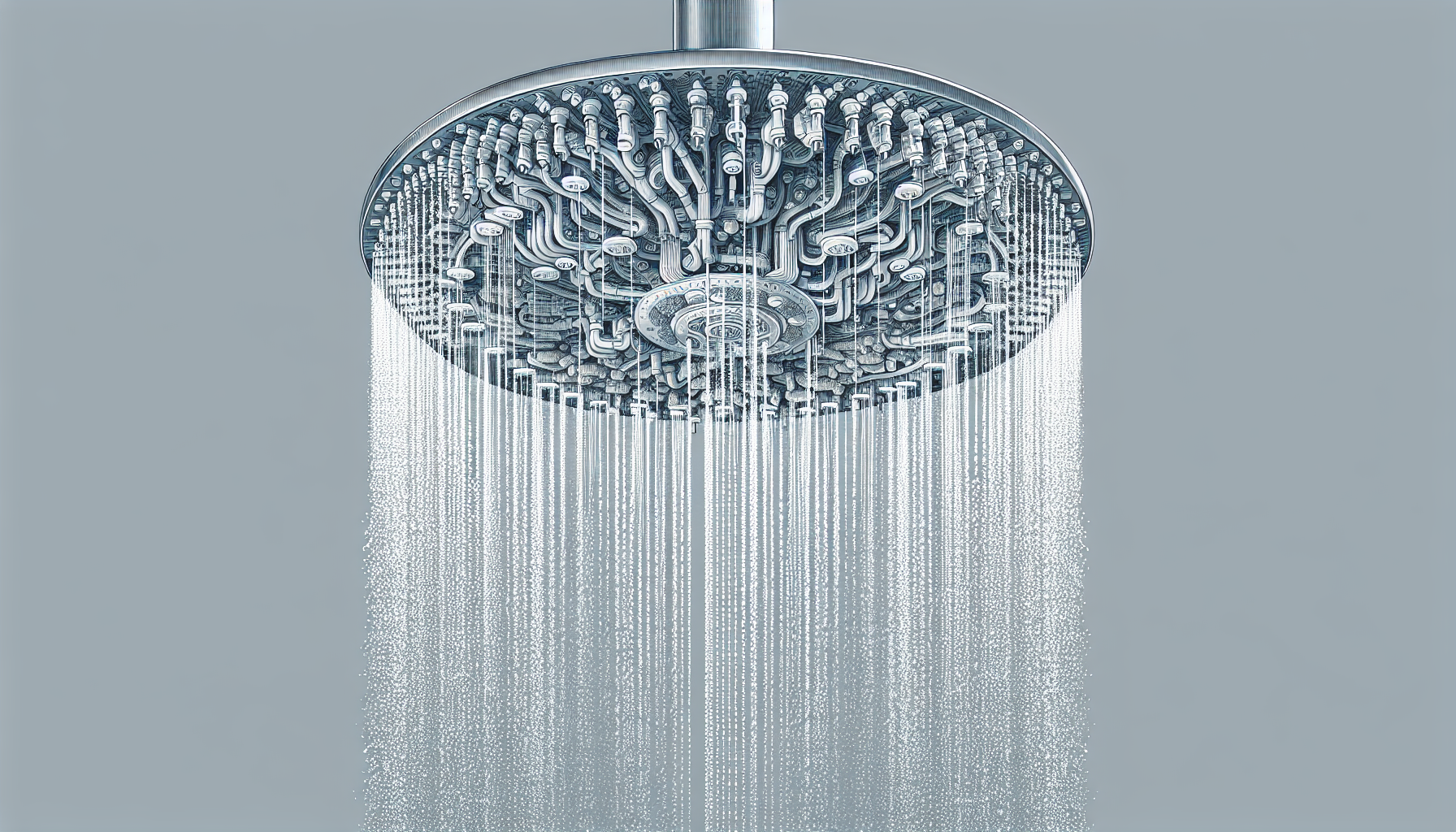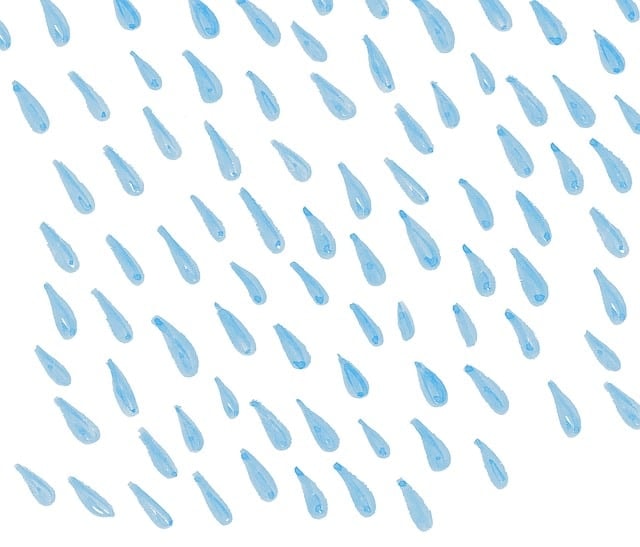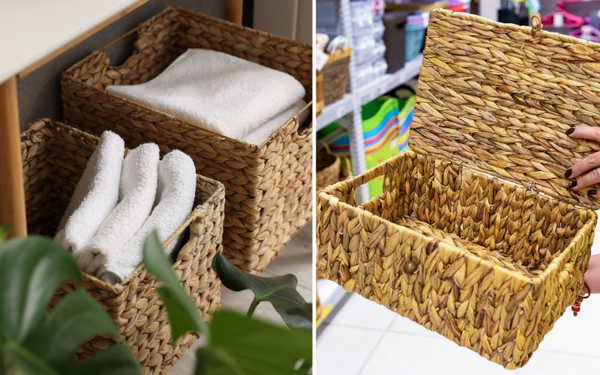Do rainfall shower heads use more water? The answer depends on their design and flow rate. In this article, we will explore how these shower heads work, compare their water usage with traditional models, and provide tips for maintaining water efficiency.
Key Takeaways
- Rainfall shower heads provide a luxurious and aesthetically pleasing shower experience with their wide and gentle water flow, mimicking the sensation of standing in a gentle rainstorm.
- While there is a common misconception that rainfall shower heads use more water, many models are designed to be water-efficient with flow restrictors and aerating technology to reduce water consumption.
- Factors such as water pressure, flow rate, shower duration, and spray settings influence water usage in rainfall shower heads, and choosing eco-friendly models and adjusting shower habits can help manage and minimize water consumption effectively.
Understanding Rainfall Shower Heads

Rainfall shower heads serve as more than a functional bathroom fixture, they also act as a statement piece. Typically installed by hanging from the ceiling or mounted high on a wall, these shower heads add a touch of sophistication and elegance to any bathroom decor. Unlike traditional shower heads, which focus the water flow in a narrow stream, rainfall shower heads produce a gentle flow that mimics raindrops falling, creating a unique and soothing showering experience.
Available in various shapes and sizes, these shower heads often feature amenities such as LED illumination, multiple spray settings, and precise temperature control. With their ability to distribute water over a large area, rainfall shower heads ensure full-body coverage without the need for constant movement, making them a favorite in many master bathrooms and luxurious guest baths.
What is a Rainfall Shower Head?
Designed to mimic the gentle, continuous flow of rain showers, a rainfall shower head provides a relaxing, immersive experience. These many rain shower heads typically range in size from 6 to 8 inches in diameter, significantly larger than a regular shower head, which allows them to cover a larger surface area. The design includes many nozzles that evenly distribute water, providing full-body coverage without requiring the user to move around.
Whether round or square, rainfall shower heads create the sensation of being drenched in a soft cascade of water. This design not only enhances the showering experience but also contributes to a more aesthetically pleasing bathroom environment, often making them a focal point in high-end bathroom designs.
How Do Rainfall Shower Heads Work?

By distributing water over a wide area, rainfall shower heads create a cascading waterfall effect. Their larger surface area compared to regular shower heads results in a more extensive water distribution, which is why they are often preferred for their ability to provide a gentle, enveloping shower experience.
While most models rely on gravity to disperse the water, some advanced designs incorporate air injection technology to enhance the water flow, making the shower feel more immersive.
Water Consumption: Myths vs. Reality
A common misconception is that rainfall shower heads consume more water than traditional models. While it’s true that their larger size and wider coverage could suggest higher water usage, many rainfall shower heads are designed to be water-efficient. These models often limit the water flow to comply with regulations and maintain a satisfying shower experience without excessive water consumption.
In reality, rainfall shower heads can have similar or even lower water consumption compared to traditional shower heads when equipped with flow restrictors. Understanding the truth behind these myths is crucial for making an informed decision about installing a rainfall shower head in your home.
Comparing Flow Rates

There can be significant variation in the flow rates for shower heads. Standard shower heads in the USA typically flow at 2.5 gallons per minute (GPM). However, shower heads can range from as low as 1.5 GPM to as high as 4.0 GPM, with some models designed for higher pressure exceeding these limits. This variance means that not all rainfall shower heads are created equal, and some can be just as water-efficient as traditional models.
For instance, some rainfall shower heads can have flow rates as high as 5.5 GPM, but most operate within the legal limit of 2.5 GPM or lower. It’s important to check the flow rate specifications when choosing a rainfall shower head to ensure it meets your water efficiency goals.
Impact of Flow Restrictors
Making rainfall shower heads water-efficient, flow restrictors play a key role. These devices mix air with water to reduce overall water consumption while ensuring a comfortable shower experience. Technologies like aerators in low-flow showerheads maintain comfort and pressure by mixing air with water, which reduces water use without compromising the shower’s effectiveness.
Some rainfall shower heads are designed with adjustable flow restrictors, allowing users to:
- Customize the water flow according to local regulations and personal preferences
- Optimize water usage
- Maintain consistent performance even at low water pressures.
Factors Influencing Water Usage
Factors such as water pressure, flow rate, duration of showers, and spray settings, influence water usage in rainfall shower heads. Each of these elements plays a crucial role in determining how much water is consumed during a shower. Understanding these factors can help you manage water usage more effectively and make informed decisions about your showering habits.
Water Pressure and Flow Rate
In rainfall shower heads, water usage is significantly determined by water pressure and flow rate. Flow rate, measured in gallons per minute (GPM), directly impacts the amount of water used. Higher water pressure can lead to increased water consumption, as it results in a higher flow rate and more water being used. Conversely, lower flow rates can lead to longer warm-up times, wasting both water and energy as it takes longer to reach the desired temperature.
State-specific regulations can also affect flow rates, with stricter limits in some places. For example, California has a maximum flow rate of 1.8 GPM for shower heads. Most rainfall showers rely on gravity to distribute water, which can help compensate for lower pressure and maintain a consistent shower experience.
Duration of Showers
Another critical factor affecting water consumption is the length of time spent in the shower. The average American shower lasts about 8 minutes and uses between 17 to 20 gallons of water. Regardless of the type of shower head, longer showers will inevitably lead to higher water usage.
Reducing shower duration is one of the most effective ways to minimize water usage, regardless of the shower head type.
Spray Settings
Water usage can also be influenced by different spray settings on rainfall shower heads. Settings like stream, atomizing, and aerating sprays alter how water is dispersed and experienced, affecting the volume of water used.
Many eco-friendly rainfall shower heads come with adjustable settings to control water flow and pressure, helping to balance water efficiency with a satisfying shower experience.
Water Efficiency and Environmental Impact
Despite often being perceived as water guzzlers, rainfall shower heads can be eco-friendly with the appropriate design. While they have the potential to increase water consumption due to their generous flow of water, many models are designed to conserve water and reduce environmental impact. Understanding the options available can help you choose a rainfall shower head that aligns with your sustainability goals.
Eco-Friendly Models
Designed to use less water, eco-friendly rainfall shower heads:
- Maintain adequate pressure and a comfortable shower experience
- Some models use as little as 1.5 or 1.8 gallons per minute (GPM), significantly reducing water usage
- WaterSense-labeled rainfall shower heads meet EPA criteria and use no more than 2.0 GPM, promoting water conservation without sacrificing performance.
Many of these eco-friendly models incorporate aerating technology, which mixes air with water to create a misty spray that feels luxurious while using less water. By choosing a water-efficient rainfall shower head, you can enjoy a spa-like experience while contributing to environmental sustainability.
Reducing Your Water Footprint
Simple changes in your showering habits can help reduce your water footprint. Showers account for 17% of indoor water use in the United States, consuming about 40 gallons of water per family per day. By shortening your shower time by just three minutes, you can save approximately 7.5 gallons of water per shower.
Installing accessories like thermostatic valves, which automatically shut off water flow once it reaches a certain temperature, can also help prevent water waste while waiting for the shower to heat up. Water-saving spray settings, such as trickle or eco spray, further reduce water flow without compromising the effectiveness of your shower.
Installation and Maintenance Considerations
To ensure the optimal performance and water efficiency of rainfall shower heads, proper installation and regular maintenance are crucial. This involves not only the physical installation but also ongoing upkeep to prevent issues like leaks and mineral buildup.
Proper Installation
Professional help is often required to install a rainfall shower head, especially if it involves running new plumbing lines to the ceiling. Ceiling-mounted rain shower heads need to be firmly attached and sealed to avoid water leakage. Ensuring that the shower arm is properly installed and using thread seal tape can prevent leaks and maintain water efficiency.
Homeowners can avoid most installation challenges by:
- Hiring a qualified plumber, who can ensure that the rainfall shower head is securely installed and performs optimally
- Regularly checking for leaks
- Addressing issues like faulty regulators
These steps can improve adequate water pressure and prevent hot water wastage.
Regular Maintenance
To prevent mineral buildup and maintain water efficiency, regular maintenance of rainfall shower heads is essential. Detachable shower heads should be cleaned periodically by soaking them in a solution of bathroom cleaner, soapy water, or white vinegar mixed with warm water. This helps remove any dirt and residue, ensuring a consistent and efficient water flow.
Enhancing Your Shower Experience Without Extra Water
A better shower experience doesn’t necessarily require using more water. By combining rainfall shower heads with handheld units and using adjustable spray settings, you can enjoy a luxurious shower without increasing your water consumption.
Combining with Handheld Showerheads
Pairing a handheld showerhead with a rainfall showerhead offers flexibility and better control in rinsing hard-to-reach areas. A handheld showerhead allows for more targeted cleaning, making it easier to rinse off soap or shampoo efficiently, thus reducing the need for prolonged water use.
By using a diverter valve, you can switch between the rainfall showerhead and the handheld unit, ensuring that you get the best of both worlds without compromising on water efficiency. This combination can provide a full-body soak and a focused spray, enhancing your overall shower experience.
Using Adjustable Spray Settings
Adjustable spray settings on rainfall shower heads allow users to customize their shower experience while balancing water efficiency. Many luxury shower heads come with options like mist, massage, or rain modes, enabling you to choose a setting that suits your mood and needs.
These adjustable settings can help you save water without sacrificing comfort and enjoyment.
Are Rainfall Shower Heads Worth It?
The worthiness of investing in rainfall shower heads depends on the weighing of their pros and cons, making rain showers worth considering. They offer a unique, luxurious experience but may come with downsides such as increased water usage and higher costs.
By understanding these factors, you can make an informed decision about whether a rainfall shower head is right for you.
Pros of Rainfall Shower Heads
The significant advantages offered by rainfall shower heads, often referred to as rain shower head pros, make them a popular choice among many homeowners. Some of the primary benefits include:
- Wide coverage, mimicking the sensation of standing in a gentle rainstorm
- Full-body coverage, ensuring that you don’t need to move around to rinse off
- More relaxing and efficient shower experience
Additionally, rainfall shower heads enhance the aesthetic appeal of your bathroom, giving it a more elegant and sophisticated look. They are often featured in high-end hotels and are popular among interior designers for their ability to transform a standard bathroom into a luxurious retreat.
The combination of functionality and style makes rainfall shower heads a worthwhile investment for those looking to upgrade their showering experience.
Cons of Rainfall Shower Heads
While rainfall shower heads offer many benefits, they do have some drawbacks. One of the main concerns is the potential for increased water usage due to their larger coverage area. This can lead to higher water bills and environmental concerns, especially in regions with water scarcity. Additionally, higher-end rain shower heads can be more expensive than standard models, which might not fit everyone’s budget.
Another drawback is that rainfall shower heads are often fixed and cannot be adjusted easily. This means you might have to step out of the water flow to apply shampoo or soap, which can be less convenient compared to traditional or handheld shower heads. Understanding these cons is essential for making an informed decision about whether a rainfall shower head is the right choice for your bathroom.
Summary
Rainfall shower heads offer a unique and luxurious showering experience, with wide coverage and aesthetic appeal. However, they can also lead to increased water usage and higher costs. By considering factors like water pressure, flow rate, and eco-friendly models, you can make an informed decision about whether a rainfall shower head is worth the investment. Ultimately, with proper installation and maintenance, you can enjoy the benefits of a rainfall shower head while minimizing its environmental impact.
Frequently Asked Questions
What are the benefits of a rain shower head?
A rain shower head provides a gentle, even flow of water that simulates rainfall, offering a soothing and relaxing sensation, perfect for unwinding after a long day or starting your morning feeling refreshed.
Do rainfall shower heads use more water than traditional shower heads?
Rainfall shower heads do not necessarily use more water than traditional shower heads, as many are designed to be water-efficient, especially when equipped with flow restrictors.
Can I install a rainfall shower head myself?
It's best to hire a professional plumber for installing a rainfall shower head to ensure proper installation and prevent leaks.
Are there eco-friendly rainfall shower heads?
Yes, many rainfall shower heads are designed to be eco-friendly, using technologies like aerators to reduce water usage while maintaining pressure.
How do I maintain my rainfall shower head?
To maintain your rainfall shower head, it's important to regularly clean it to prevent mineral buildup. You can soak detachable heads in a vinegar solution to effectively remove dirt and residue.
You Might Also Like...










